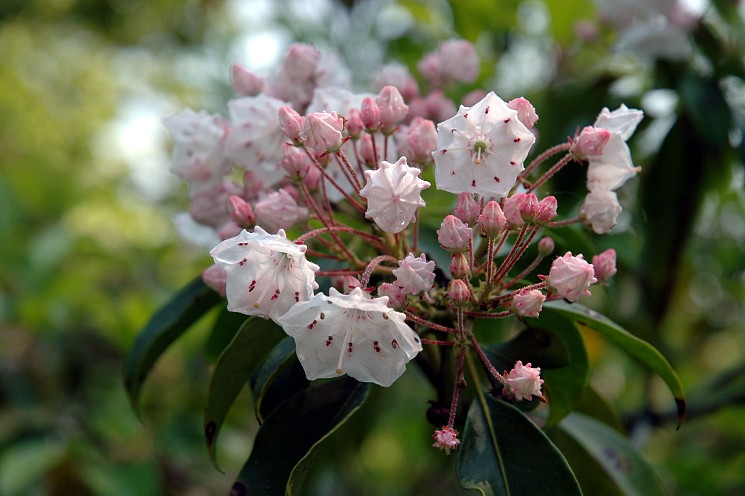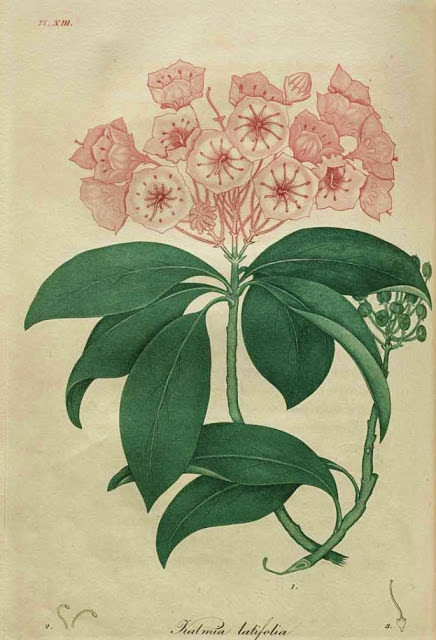Mountain Laurel, Kalmia latifolia

The mountain laurel in bloom
Adrienne Rich
Constructed like needlework
Tiny half-pulled stitches piercing
Flushed and striped petals…
Mountain Laurel, Kalmia latifolia has long been regarded as one of our finest, flowering, native shrubs. This is a broad-leaf evergreen par excellence. In June, its ribbed flower buds are a deep-pink, opening to pale pink, or white, cup-shaped flowers. Most often, these flowers are at the terminal end of branches, creating an effusive floral display. Take a close look at these flowers, which have an artful, pollinating mechanism. The five fused petals, which Rich alludes to as being stitched, surround ten stamens, the male reproductive parts. At the end of each stamen are the tiny dark-colored anthers, possessing the pollen. Notice how the petals are indented, holding the anthers, with the stamens bent back under tension. When a bee, or other insect, lands, the stamen is catapulted, with a mousetrap-like response, increasing the successful rate of pollen covered bees/insects, hence greater cross pollination. Nature’s engineering at work, right before your eyes.
Kalmia is a relatively small genus, with seven to ten species, depending upon taxonomic interpretation. But the very name is connected to notable botanical history. Peter Kalm (1715-1779), Finnish botanist, came to North America, in 1748, to collect known and unknown plants. Kalm was a former student of Carl Linnaeus (1707-1778), Swedish botanist, and the father of modern taxonomy.
Kalm spent three years collecting in North America, returning a prized trove of plants to Linnaeus in 1751. A grateful Linnaeus, named the genus of this outstanding plant in his honor. Kalm then settled into Swedish academic life, but is also remembered today for Peter Kalm’s Travels in North America an eighteenth-century natural history travelogue. Kalm, in this recount, under November 20, 1748 states, “The spoon tree, which never grows to a great height, was seen today in several places. The Swedes here [in Pennsylvania], have named it thus, because the Indians used to make their spoons and trowels of its wood…It succeeds best on the side of hills, especially on the north side… it frequently stands among beech trees. They have the quality of preserving their fine green leaves throughout the winter, so that when all other trees have lost their ornamentals, and stand quite naked, these adorn the woods with their fine foliage… About the month of May they begin to flower in these parts [in Pennsylvania], and their beauty rivals that of most of the known trees in nature.”
Prolific horticultural writer, and expert plantsman, Ernest Henry Wilson (1876-1930), adds this praise, “…but the typical Mountain Laurel overshadows all, dominates the scene, defies descriptive effort, lays a hush on the tongue and thrills the soul with the majesty of its beauty.” Wilson further extols Kalmia’s winter prowess, while comparing it to rhododendron, “…the evergreen Rhododendrons hang down their leaves and curl them to the utmost. In marked contrast is the Mountain Laurel (Kalmia latifolia) holding its leaves outspread as in summertime, and glorying in the fact that it is New England’s best and worthiest broadleaf evergreen.”
Visionary founder of Mount Auburn, Jacob Bigelow (1787- 1879), physician, and botanist, also praised the beauty of Mountain Laurel, Kalmia latifolia. In his American Medical Botany, 1817-1820, one of America’s first botanical books with colored illustrations, Bigelow wrote, “As an ornamental shrub, this species stands in the highest rank, and by the frequency of its growth and the brilliancy of its flowers, it contributes in a great degree to the eloquence of the natural scenery in those mountains and woods, which it inhabits.” For these three volumes, Bigelow also drew the illustrations, and devised a method of inking directly the printing plate, called color aqua-tinting, that eliminated the then usual need for hand coloring, of finished pages.

In June, with over one-hundred Mountain Laurels throughout our landscape, you will have little trouble seeking out these beautiful (and “naturally engineered”) flowers, for a close-up view, and join the legacy of plant aficionados that have marveled at their elegance, and charm.
Leave a Reply